
|
|
July 3-10, 2002
Droitwich and Brookmans Park, England
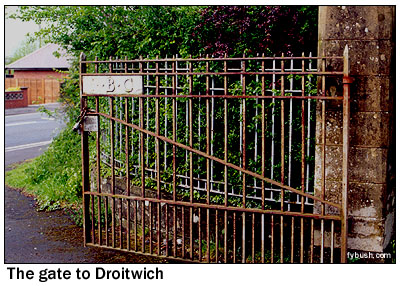
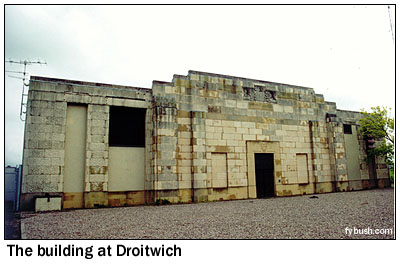
Until now, all the sites we've presented here at Tower Site of the Week have had one important thing in common: they've all been on the same side of the Atlantic Ocean.
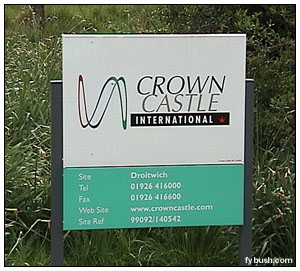 But
in late April and early May of 2002, your editor had the opportunity
to spend some time in England and France. And with the kind permission
of Mrs. Editor, the vacation even included a few stops at interesting
and important tower sites.
But
in late April and early May of 2002, your editor had the opportunity
to spend some time in England and France. And with the kind permission
of Mrs. Editor, the vacation even included a few stops at interesting
and important tower sites.
This week, we'll look at two sites that were among the BBC's earliest major domestic transmission facilities, and still provide long-wave and medium-wave transmission to a huge chunk of the British Isles.
We'll start at Droitwich, a quiet town in the Worcestershire countryside, 20 miles or so southwest of Birmingham along the M5 motorway. Head south from Birmingham, as we did one gray April day, and you'll see some tall towers as you approach junction 5. Get off the motorway and head north on the A38 (away from Droitwich itself) and you'll soon find yourself (after passing several fields full of sheep!) at the gate shown above, with that "B B C" lettering that's seen better days.
Droitwich (the site, not the town) was built by the BBC in 1934 as a high-power longwave site, operating then at 200 kilocycles. With 400 kilowatts of power, this transmitter covered all of England and much of Scotland, Wales, Ireland and western Europe, requiring just two additional synchronous transmitters in northern Scotland (at Burghead and Westerglen) to fill in the signal. The longwave signal carried the BBC's National Programme Service; after the war's end, it was used instead for the new Light Programme, which began service on 29 July 1945.
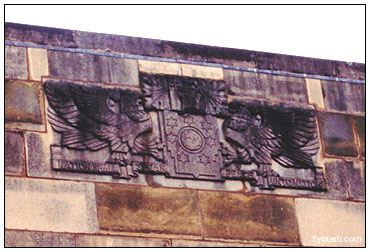 Look
carefully at the crest above the door and you'll see the BBC's
pre-war motto, "Nation Shall Speak Peace Unto Nation."
Look
carefully at the crest above the door and you'll see the BBC's
pre-war motto, "Nation Shall Speak Peace Unto Nation."
Medium-wave service from Droitwich was also in place before the war, carrying the "Alternative Service" for the Midlands, later replaced by the Forces Programme and supplanted after war's end by the Home Service.
By the early 1960s, Droitwich was carrying the Home Service on 1088 kilocycles (276 meters) with 150 kilowatts, as well as the longwave Light Programme transmitter.
With the BBC offering the only licensed radio service in Britain, offshore pirates became increasingly popular in the sixties - and the BBC responded by reorganizing its services again in 1967. The old Light Programme on 200 kHz became Radio Two, with what we'd now call adult contemporary music. The Home Service on 1088 became Radio Four, offering primarily talk and cultural programming. And for the young audience, the BBC introduced Radio One, heard from Droitwich on a 30 kW transmitter at 1214 kHz. (What about Three? The "serious music" service, the outgrowth of the old Third Programme, was heard on 647 kHz from a separate site some 30 miles to the east at Daventry.)
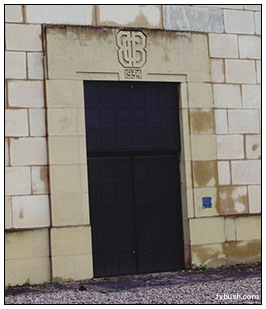 Another reconfiguration
of the European radio dial in 1978 shifted Droitwich's frequencies
considerably. The big longwave transmitter shifted to Radio Four,
and soon moved from 200 kHz to 198 kHz. The old Radio Four/Home
Service transmitter that had been on 1088 moved to 1053 with
150 kW as the new home of Radio One. The 1214 kHz Radio One transmitter
became Radio Three on 1215 kHz (although by then, "VHF/FM"
was beginning to supplant medium wave for serious music listening),
and a new 150 kilowatt transmitter was brought into service on
693 kHz for Radio Two.
Another reconfiguration
of the European radio dial in 1978 shifted Droitwich's frequencies
considerably. The big longwave transmitter shifted to Radio Four,
and soon moved from 200 kHz to 198 kHz. The old Radio Four/Home
Service transmitter that had been on 1088 moved to 1053 with
150 kW as the new home of Radio One. The 1214 kHz Radio One transmitter
became Radio Three on 1215 kHz (although by then, "VHF/FM"
was beginning to supplant medium wave for serious music listening),
and a new 150 kilowatt transmitter was brought into service on
693 kHz for Radio Two.
What had happened, in effect, was the creation of two new synchronized networks across Britain, as well as several national regions, from the old regional Home Service frequencies. That 693 frequency was the successor to the 692 that had been used for the Northern Service at Moorside Edge, near Manchester. Paired with 693 for Radio Two was a new national channel on 909, the former London Home Service 908 kHz channel. In addition to the 1053 channel for Radio One, using the old 1052 kHz South and West Home Service frequency, other parts of the country heard Radio One on 1089, successor to the old 1088 Midlands Home Service channel from Droitwich. The old Welsh Home Service on 881 became Radio Wales on 882, a new national service for Wales; the Scottish Home Service on 809 became Radio Scotland on 810; the Northern Ireland Home Service on 1340 became Radio Ulster on 1341 - and several other former regional Home Service frequencies (1485, 1458 and 1152) became available for local commercial radio.
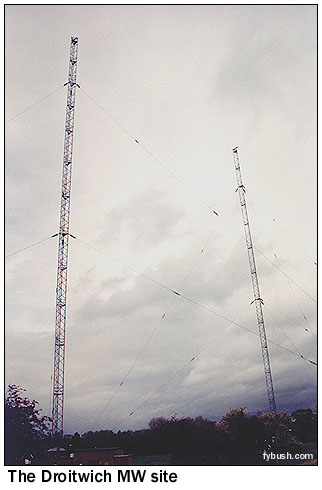
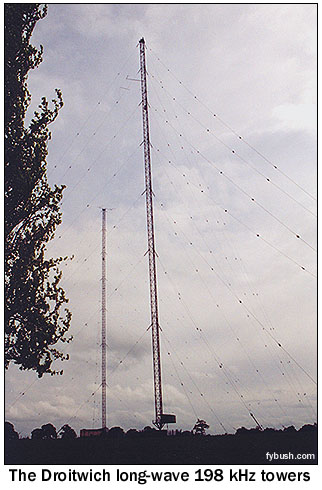
National commercial radio arrived in the nineties, with the end of the BBC's simulcasts on LW/MW and FM. Radio Four stayed on that 198 kHz signal, along with FM channels nationwide, while Radios One, Two and Three became FM only. Radio One's old 1053/1089 kHz transmitters across Britain became the home of Talkradio UK, later known as TalkSport. The Radio Two transmitters on 1215 kHz became Virgin Radio, and Radio Three on 693 and 909 became the BBC's new talk-and-sports Radio Five Live.
And
that's roughly the lineup you'll find today if you visit Droitwich.
Pull down the long driveway and you'll see two two-tower arrays
on either side. To the north (shown at left above) is a medium-wave
array that carries Five Live on 693, TalkSport on 1053 and Virgin
on 1215; to the right are the very tall (more than 600 foot)
towers of Radio Four on 198.
Another bit of trivia about that longwave signal: it was used for many years (and still is, I believe) as a standard time/frequency signal for the British Isles, much as WWV/WWVH/WWVB were and are in the U.S.
One big thing that has changed here in recent years is the ownership of this and the other BBC sites. As part of the mania for privatization that has swept Europe in recent years, the BBC sold its transmission facilities a few years back. The shortwave sites (such as Daventry and Woofferton) went to a company called Merlin, while the domestic sites ended up in the hands of a multinational tower company called Crown Castle. Pretty much every former BBC site, from the loftiest (like this) to the little relay sites that consist of nothing more than a longwire or a low-power FM relay (what we'd call a translator) on the side of a water tower, now bears one of the green-and-white signs shown above. (We dialed that 01926-416000 number several times during our visit, trying without success to arrange visits inside these sites; alas, the timing didn't work this trip...)
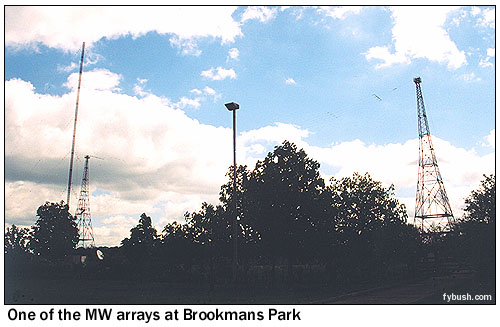
From Droitwich we headed across Worcestershire and Warwickshire to Stratford and a pleasant evening of theater - and the following day brought some blue skies as we pointed the rental Fiat south and east towards London. Before returning the car at Heathrow, we headed around the "M25 Orbital Motorway" (what we'd call a beltway here) to junction 24, where the A1000 crosses the M25 some 12 miles north of central London.
A short drive north on the A1000 brought us to another gate and another long driveway: the entrance to the Brookmans Park facility that has provided medium-wave radio to greater London and the southeast since the late 1930s.
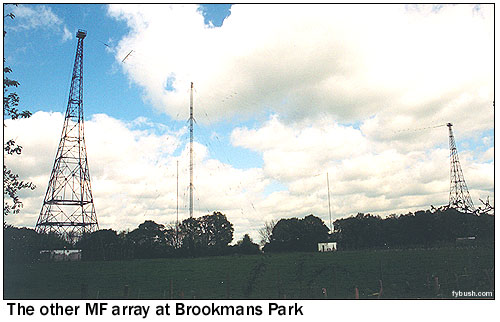
Head back into history and you'd find the main transmitter here running 140 kilowatts on 908 kilocycles or 330 meters, bringing the Home Programme to London. The Light Programme was heard on 1214 kc/247m with 50 kilowatts. The 1967 reconfiguration made the 908 transmitter into the Radio Four outlet, with 1214 going to Radio One, and 1978's reshuffling saw 908 become 909 with Radio Three and 1214 become 1215 with Radio Two. Remember the 1088 frequency that Droitwich had used? That moved down to London and became 1089, carrying Radio One with 150 kilowatts. And still another 50 kilowatt signal was operating here by 1978 as well, carrying the BBC's local Radio London service on 1458 kHz with 50 kW.
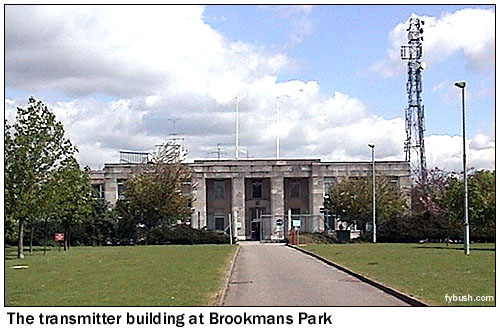 Today's
Brookmans Park lineup looks like this: BBC Five Live on 909,
TalkSport on 1089, Virgin on 1215 (though most Londoners prefer
the London-only FM relay on 105.8) and Asian-language Sunrise
Radio on 1458 (the local BBC service having gone FM-only on 94.9).
Today's
Brookmans Park lineup looks like this: BBC Five Live on 909,
TalkSport on 1089, Virgin on 1215 (though most Londoners prefer
the London-only FM relay on 105.8) and Asian-language Sunrise
Radio on 1458 (the local BBC service having gone FM-only on 94.9).
Without an engineer nearby, I'm not sure which of the arrays shown above carries which signal; my guess is that the top photo (showing the view to the right of the transmitter building) shows 1089 using that longwire hammock stretching between the two self-supporters, while the one at the bottom (the view to the left of the driveway) illustrates the 909 antenna between the self-supporters. The lower-powered 1215 and 1458 signals likely use those guyed towers, but I'm really not certain.
In any event, medium-wave transmission is just part of the game here at Brookmans Park these days; this is a major uplink-downlink facility for British TV and other satellite users as well, and that seems to be the big business for Crown Castle at this site now. (Indeed, the friendly security guard who walks out to see what this strange American is up to doesn't even know which broadcasters use these antennas, guessing vaguely that Radio One and Radio Two must be around here somewhere!)
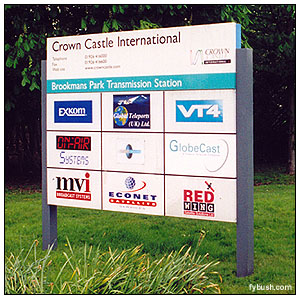 Not
far from here, along the A1 highway that heads south into London,
is a very rare sight in Britain: a standard North American-style
four-tower in-line directional array. Most MW signals in Britain
are either nondirectional or generate their directionality from
sloping wires off the tower (pardon, "mast"!); this
site, known as "Saffron Green," was built to aim independent
local radio stations LBC (on 1152) and Capital Gold (on 1548)
into London while nulling other stations on those channels just
100 or so miles away. Alas, we were moving too fast to get a
good picture.
Not
far from here, along the A1 highway that heads south into London,
is a very rare sight in Britain: a standard North American-style
four-tower in-line directional array. Most MW signals in Britain
are either nondirectional or generate their directionality from
sloping wires off the tower (pardon, "mast"!); this
site, known as "Saffron Green," was built to aim independent
local radio stations LBC (on 1152) and Capital Gold (on 1548)
into London while nulling other stations on those channels just
100 or so miles away. Alas, we were moving too fast to get a
good picture.
Piqued your curiosity about British towers? Never fear - there's another site that can keep you busy for weeks. Mike Brown is as fascinated by towers over there as we are by towers over here, and he's put a lot of work into the Transmitter Mast Gallery, a small part of a wonderfully eccentric British Webring that goes by the name of Transdiffusion Today.
Your editor (and a heavily jetlagged Mrs. Editor) had the pleasure of meeting Mike for dinner around the corner from the famous BBC Broadcasting House in London; we're pleased to announce that this strange obsession with radio is indeed a global thing and knows no national boundaries. Go check out his site (where you'll find some other views of these neat sites, as well as evidence that everyone ends up photographing the Crown Castle signs at each site), and you should be done just in time for next week's visit to some big European TV and FM facilities. See you then!
- Previous Site of the Week: Nashville, Tennessee, part two
- Next Week: Crystal Palace, London and the Eiffel Tower, Paris
- How can you help support Site of the Week? Click here!
- Submit your suggestions for a future Site of the Week!
